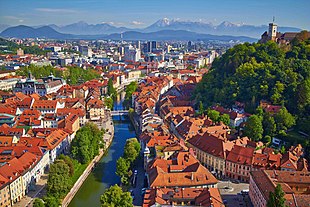
Back اقتصاد سلوفينيا Arabic Эканоміка Славеніі Byelorussian Икономика на Словения Bulgarian Economia d'Eslovènia Catalan Ekonomika Slovinska Czech Slowenische Wirtschaft German Οικονομία της Σλοβενίας Greek Economía de Eslovenia Spanish Économie de la Slovénie French Economía de Eslovenia Galician
 The city of Ljubljana is the capital and financial centre of Slovenia. | |
| Currency | Euro (EUR, €) |
|---|---|
| 1 January – 31 December | |
Trade organisations | EU, WTO, OECD |
Country group | |
| Statistics | |
| Population | |
| GDP | |
| GDP rank | |
GDP growth |
|
GDP per capita | |
GDP per capita rank | |
GDP by sector |
|
| |
Population below poverty line | |
| |
Labour force | |
Labour force by occupation |
|
| Unemployment | |
Average gross salary | €2,427 / $2,639 monthly (November 2023) |
| €1,594 / $1,733 monthly (November 2023) | |
Main industries | ferrous metallurgy and aluminum products, lead and zinc smelting; electronics (including military electronics), trucks, automobiles, electric power equipment, wood products, textiles, chemicals, pharmaceuticals, machine tools [14] |
| External | |
| Exports | |
Export goods | manufactured goods, machinery and transport equipment, chemicals, food [14] |
Main export partners | |
| Imports | |
Import goods | machinery and transport equipment, manufactured goods, chemicals, fuels and lubricants, food |
Main import partners | |
FDI stock | |
Gross external debt | |
| Public finances | |
| Revenues | 44.2% of GDP (2019)[16] |
| Expenses | 43.7% of GDP (2019)[16] |
| Economic aid |
|
| |
All values, unless otherwise stated, are in US dollars. | |

The economy of Slovenia is a developed mixed economy.[21][22] The country enjoys a high level of prosperity and stability as well as above-average GDP per capita by purchasing power parity at 92% of the EU average in 2022.[23] The nominal GDP in 2023 is 68.108 billion USD, nominal GDP per capita (GDP/pc) in 2023 is USD 32,350.[4] The highest GDP/pc is in central Slovenia, where the capital city Ljubljana is located. It is part of the Western Slovenia statistical region, which has a higher GDP/pc than eastern Slovenia.[24]
In January 2007, Slovenia became the first member to have both joined the European Union and adopted the euro, and the first ex-Yugoslav republic to join the eurozone. It has also been a member of the Organisation for Economic Co-operation and Development since 2010.[25]
Slovenia has a highly educated workforce, well-developed infrastructure, and is situated at a major transport crossroads.[25] The level of foreign direct investment is one of the lowest but has been steadily rising in the last few years. The Slovenian economy has been affected by the European economic crisis, which occurred in the late 2000s.[25] After 2013, GDP per capita began rising again.[26] Almost two-thirds of the working population is employed in services.[5]
- ^ "World Economic Outlook Database, April 2019". IMF.org. International Monetary Fund. Retrieved 29 September 2019.
- ^ "World Bank Country and Lending Groups". datahelpdesk.worldbank.org. World Bank. Retrieved 29 September 2019.
- ^ "Population, Slovenia, 1 April 2021". stat.si. Statistical Office of the Republic of Slovenia. 29 July 2021. Retrieved 23 October 2021.
- ^ a b c d e f g "Report for Selected Countries and Subjects: April 2024". imf.org. International Monetary Fund.
- ^ a b c d e f g h "CIA World Factbook". CIA.gov. Central Intelligence Agency. Retrieved 11 January 2019.
- ^ "Income, Poverty and Social Exclusion". stat.si. SURS. Retrieved 19 June 2020.
- ^ "People at risk of poverty or social exclusion". ec.europa.eu. Eurostat. Retrieved 15 April 2024.
- ^ "Gini coefficient of equivalised disposable income - EU-SILC survey". ec.europa.eu/eurostat. Eurostat. Retrieved 5 June 2024.
- ^ a b "Human Development Report 2023/2024" (PDF). United Nations Development Programme. 13 March 2024. Archived (PDF) from the original on 13 March 2024. Retrieved 1 May 2024.
- ^ "Labor force, total - Slovenia". data.worldbank.org. World Bank. Retrieved 1 November 2019.
- ^ "Employment rate by sex, age group 20-64". ec.europa.eu/eurostat. Eurostat. Retrieved 30 May 2019.
- ^ "Unemployment by sex and age - monthly average". appsso.eurostat.ec.europa.eu. Eurostat. Retrieved 4 October 2020.
- ^ "Unemployment rate by age group". data.oecd.org. OECD. Retrieved 8 September 2020.
- ^ a b "Aktivno prebivalsto". Statistical Office of the Republic of Slovenia, Slovenia. 18 November 2014. Demographic. Archived from the original on 12 December 2014.
- ^ a b c d "Exports and imports of goods, December 2022". stat.si. Retrieved 10 October 2020.
- ^ a b c d e f "Euro area and EU27 government deficit both at 0.6% of GDP" (PDF). ec.europa.eu/eurostat. Eurostat. Retrieved 28 April 2020.
- ^ "Archived copy" (PDF). Archived (PDF) from the original on 25 December 2017. Retrieved 25 December 2017.
{{cite web}}: CS1 maint: archived copy as title (link) - ^ "Archived copy" (PDF). Archived (PDF) from the original on 20 April 2017. Retrieved 25 December 2017.
{{cite web}}: CS1 maint: archived copy as title (link) - ^ "Ministrstvo za finance". www.mf.gov.si.
- ^ "Scope affirms Slovenia's A/Stable long-term credit ratings". Scope Ratings. Retrieved 29 July 2023.
- ^ "An Analysis of the Economic System of Slovenia - Economic Activity". 20 May 2023. Retrieved 16 June 2024.
- ^ "Slovenia: Introduction". globaledge.msu.edu. Retrieved 16 June 2024.
- ^ https://ec.europa.eu/eurostat/databrowser/view/TEC00114/default/table?lang=en&category=prc.prc_ppp [bare URL]
- ^ "Bruto domači proizvod po regijah, Slovenija, 2015". www.stat.si.
- ^ a b c "Osnovni gospodarski podatki o Sloveniji" [Basic Economic Data about Slovenia] (in Slovenian). Embassy of the Republic of Slovenia Vienna. Archived from the original on 18 June 2012. Retrieved 15 March 2012.
- ^ "SURS". www.stat.si.
© MMXXIII Rich X Search. We shall prevail. All rights reserved. Rich X Search